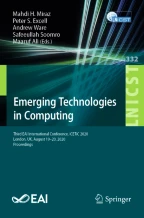Abstract
This is a review paper that covers the various technologies used for underwater communications. Research in this domain was initially restricted and in the defence sector but is now gaining much civilian exposure and applications. Communication was mainly with submarines using extremely low and very low electromagnetic frequencies. The review covers communication using acoustic waves, electromagnetic waves, combining acoustic and radio transmission and finally optical transmission. The benefits of various technologies are summarized, including hybrid techniques. For short distance communications, for example between Scuba divers and the ship, optical frequencies are feasible. For long distance undersea communications, very low electromagnetic frequencies are still the most established way to maintain contact, whilst the vessel remain submerged.
Access this chapter
Tax calculation will be finalised at checkout
Purchases are for personal use only
Similar content being viewed by others
References
Ainslie, M.A., McColm, J.G.: A simplified formula for viscous and chemical absorption in sea water. J. Acoust. Soc. Ame. 103(3), 1671–1672 (1998). https://doi.org/10.1121/1.421258, https://asa.scitation.org/doi/10.1121/1.421258
https://qph.fs.quoracdn.net/main-qimg-0d37099e3e0534fd4b516e3f2bede31a. Accessed 09 Aug 2020
Hattab, G., El-Tarhuni, M., Al-Ali, M., Joudeh, T., Qaddoumi, N.: An underwater wireless sensor network with realistic radio frequency path loss model. Int. J. Distrib. Sens. Netw. 9(3), 1–9 (2013). https://doi.org/10.1155/2013/508708
http://www.salinityremotesensing.ifremer.fr/_/rsrc/1467884561066/sea-surface-salinity/salinity-distribution-at-the-ocean-surface/annual_clim.jpg?height=1641&width=3015. Accessed 09 Aug 2020
https://media.springernature.com/lw785/springer-static/image/art%3A10.1186%2Fs40623-017-0739-7/MediaObjects/40623_2017_739_Figa_HTML.gif. Accessed 09 Aug 2020
https://4.bp.blogspot.com/_klNpOBDR6nI/TL8BUHf5meI/AAAAAAAAAAk/RrV0Ch4kbQ0/s1600/Light+attenuation+cw+pic.bmp. Accessed 09 Aug 2020
Mullen, L.: Optical propagation in the underwater environment. In: Proceedings of the SPIE 7324, Atmospheric Propagation VI, 732409, 2 May 2009. https://doi.org/10.1117/12.820205
Wikipedia. Underwater acoustic communication. https://en.wikipedia.org/wiki/Underwater_acoustic_communication. Accessed 11 Aug 2020
Mitchell, R.: Nato Adopts New Protocol Standard for Underwater Communications. July 18 2017. https://www.allaboutcircuits.com/news/janus-nato-new-protocol-standard-underwater-communications/. Accessed 11 Aug 2020
Miraz, M.H., Ali, M., Excell, P.S., Picking, R.: Internet of nano-things, things and everything: future growth trends. Fut. Internet 10, 68 (2018). https://www.mdpi.com/1999-5903/10/8/68. Accessed 11 Aug 2020
Benattia, A., Ali, M.: Convergence of technologies in the M2M space. In: IEEE Applied Electronics 2008 International Conference, The Department of Applied Electronics and Telecommunications, University of West Bohemia, Pilsen, Czech Republic, 10–11 September 2008, pp. 9–12. ISBN 987-80-7043-654-7
Shaw, A., Al-Shamma’a, A. I., Wylie, S. R., Toal, D.: Experimental investigations of electromagnetic wave propagation in seawater. In: Proceedings of the 36th European Microwave Conference, Manchester, UK, pp. 572–575 (2006). https://doi.org/10.1109/eumc.2006.281456
Scholz, T.: Laser based underwater communication experiments in the Baltic Sea. In: 2018 Fourth Underwater Communications and Networking Conference (UComms), Lerici, 2018, pp. 1–3 (2018). https://doi.org/10.1109/ucomms.2018.8493174
Li, Y., Yin, H., Ji, X., Wu, B.: Design and implementation of underwater wireless optical communication system with high-speed and full-duplex using blue/green light. In: 2018 10th International Conference on Communication Software and Networks (ICCSN), Chengdu, pp. 99–103 (2018). https://doi.org/10.1109/iccsn.2018.8488232
Zhou, Z., Yin, H., Yao, Y.: Wireless optical communication performance simulation and full-duplex communication experimental system with different seawater environment. In: 2019 IEEE International Conference on Signal Processing, Communications and Computing (ICSPCC), Dalian, China, pp. 1–4 (2019). https://doi.org/10.1109/icspcc46631.2019.8960905
Aravind, J.V., Kumar, S., Prince, S.: Mathematical modelling of underwater wireless optical channel. In: 2018 International Conference on Communication and Signal Processing (ICCSP), Chennai, pp. 0776–0780 (2018). https://doi.org/10.1109/iccsp.2018.8524194
Jouhari, M., Ibrahimi, K., Tembine, H., Ben-Othman, J.: Underwater wireless sensor networks: a survey on enabling technologies, localization protocols, and internet of underwater things. IEEE Access 7, 96879–96899 (2019). https://doi.org/10.1109/access.2019.2928876
Chowdhury, M.Z., Hasan, M.K., Shahjalal, M., Hossan, M. T., Jang, Y.M.: Optical wireless hybrid networks: trends, opportunities, challenges, and research directions. IEEE Commun. Surv. Tutor. 22(2), 930–966. Secondquarter 2020. https://doi.org/10.1109/comst.2020.2966855
Author information
Authors and Affiliations
Corresponding author
Editor information
Editors and Affiliations
Rights and permissions
Copyright information
© 2020 ICST Institute for Computer Sciences, Social Informatics and Telecommunications Engineering
About this paper
Cite this paper
Ali, M., Miraz, M.H. (2020). A Review of Underwater Acoustic, Electromagnetic and Optical Communications. In: Miraz, M.H., Excell, P.S., Ware, A., Soomro, S., Ali, M. (eds) Emerging Technologies in Computing. iCETiC 2020. Lecture Notes of the Institute for Computer Sciences, Social Informatics and Telecommunications Engineering, vol 332. Springer, Cham. https://doi.org/10.1007/978-3-030-60036-5_6
Download citation
DOI: https://doi.org/10.1007/978-3-030-60036-5_6
Published:
Publisher Name: Springer, Cham
Print ISBN: 978-3-030-60035-8
Online ISBN: 978-3-030-60036-5
eBook Packages: Computer ScienceComputer Science (R0)
